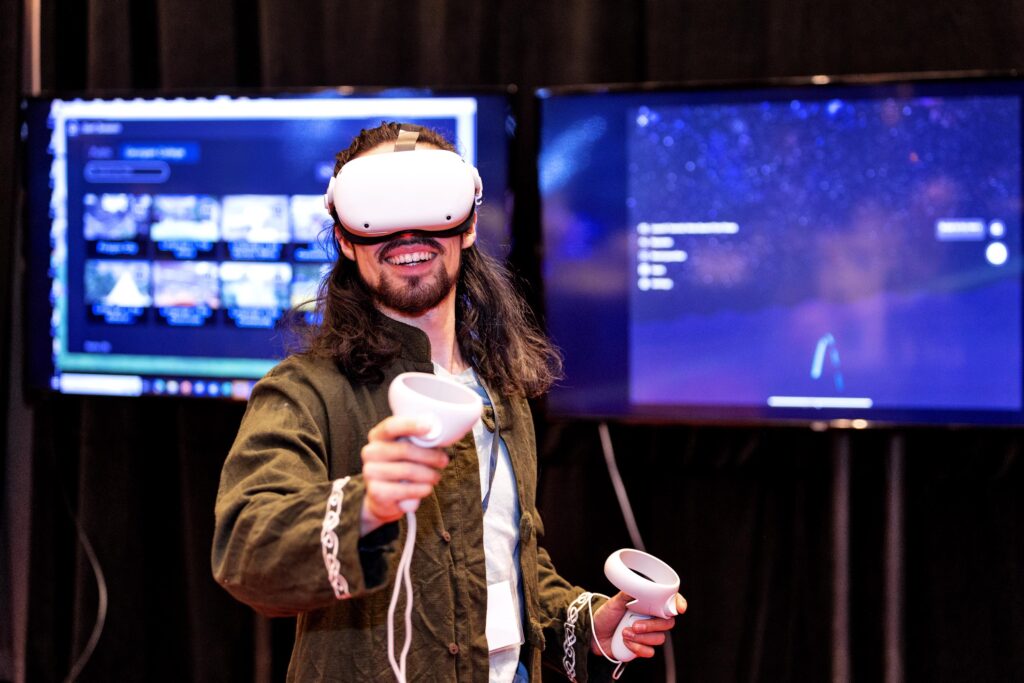
Emerging Educational Technology
Emerging educational technologies like Virtual Reality (VR), Augmented Reality (AR), Mixed Reality (MR), and Generative Artificial Intelligence (GAI) are transforming the learning landscape. These innovations provide immersive experiences that engage students in new ways, enhancing their understanding, skills, and ability to interact with complex concepts and real-world scenarios.
XR and AI at Georgian
Georgian College has been exploring and integrating virtual, mixed, and augmented reality, collectively known as “XR,” into curricula since 2018.
Virtual reality, in particular, is a medium for immersive and experiential learning that gives learners a sense of “presence”—both spatial and social—contextual environments and agency. These are the superpowers of XR that enable students to learn in the cognitive, psychomotor and affective domains.
The recent introduction of generative artificial intelligence (GAI) in 2022 is another emerging educational technology that, combined with XR, will transform the way students learn and how learning is assessed.
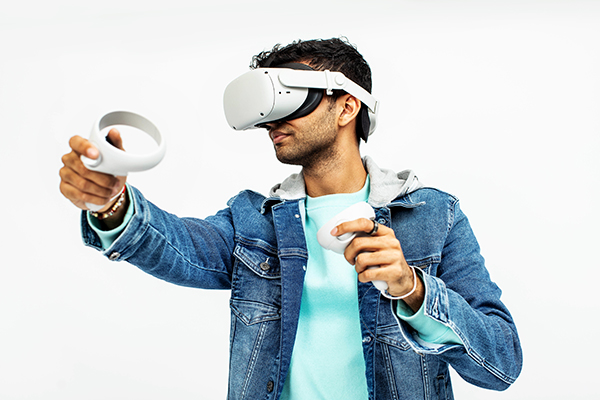
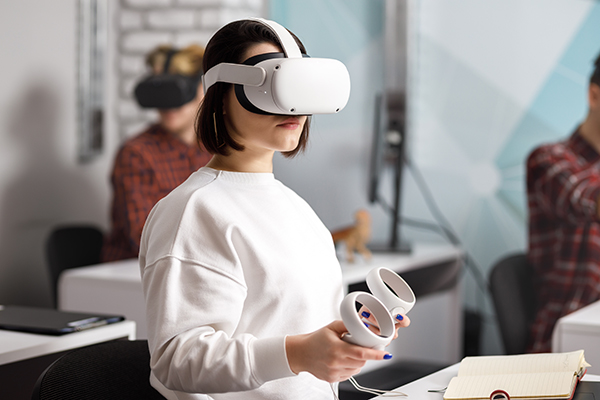
Vision
Inspire, Ideate, Integrate, Research and Iterate
Leverage emerging technologies such as XR (virtual, mixed and augmented reality) and generative artificial intelligence (GenAI or GAI) to provide students with unrivaled immersive learning experiences. Seek ways to enhance learning and transform the way students learn and how learning is assessed.
Mission
Georgian recognizes that innovation often originates with faculty. Our mission is to support faculty to explore and integrate emerging educational technologies that are transformative, sustainable and help future proof our students.
Success stories
The following is a list of links to resources and to stories of how XR & AI are being explored and integrated at Georgian College:
Academic Programs and XR-AI
- Visual Digital Media Arts (VDMA)
- Startup story: September 2024
- Professor(s): Anton Pickard
- Hardware: Quest 2
- Software: Open Brush
- Deployment Strategy: VDMS has its own VR headsets. 40 VR headsets are loaned to students from VDMA at the start of the semester and returned at the end of the semester. Students create their own accounts. Upon return of the headsets, the VDMA clean and factory reset them and redeploy to the next cohort.
- Startup story: The first program to integrate VR into their curriculum was the Architectural Technology program in 2018. Students learn to design buildings and landscapes in 2D and then enter the 3D space with a VR headset to get a spatial perspective using Revit and other software. 3D allows students to see and feel what it’s “really” like inside the spaces they’ve designed. This spatial experience and sense of presence allows a student, for example, to look at the ceiling and realize it needs to be elevated two feet, and the hallway is much wider than necessary, and the spiral staircase, while functional, needs to be moved without impacting the structural integrity of the building. A spatial perspective is critical in design and VR provides that perspective.
- Professor(s): Costan Boiangiu
- Hardware: PCVR
- Software: Revit, Enscape
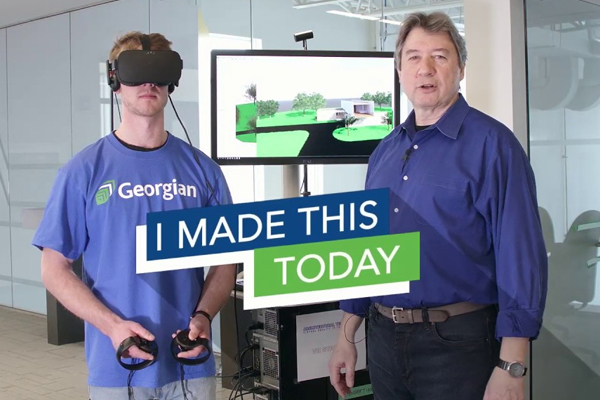
- Startup story: September 2023
- Professor(s): Dr. Sean Madorin
- Course(s): Chemistry, Microbiology, Anatomy
- Hardware: Quest Pro
- Software: Nanome. 3D Organon
- Deployment Strategy: VR headsets brought to the classroom on a power request basis
- Evidence:
- Beatrice, P., Grimaldi, A., Bonometti, S., Caruso, E., Bracale, M., & Montagnoli, A. (2024). Adding immersive virtual reality laboratory simulations to traditional teaching methods enhances biotechnology learning outcomes. Frontiers in Education, 9.
- Mercado, J., & Picardal, J. P. (2023). Virtual laboratory simulations in biotechnology: A systematic review. Science Education International, 34(1), 52–57.
- Reen, F. J., Jump, O., McEvoy, G., McSharry, B. P., Morgan, J., Murphy, D., O’Leary, N., O’Mahony, B., Scallan, M., Walsh, C., & Supple, B. (2024). Student informed development of virtual reality simulations for teaching and learning in the molecular sciences. Journal of Biological Education, 1–17.
- Startup story: September 2024
- Professor(s): Joanne Campagna
- Hardware: Vive Focus 3
- Software: Bodyswaps: Team leadership scenarios
- Deployment Strategy: The Immersive Technology team brings VR headsets to the classroom 2-3 times per semester.
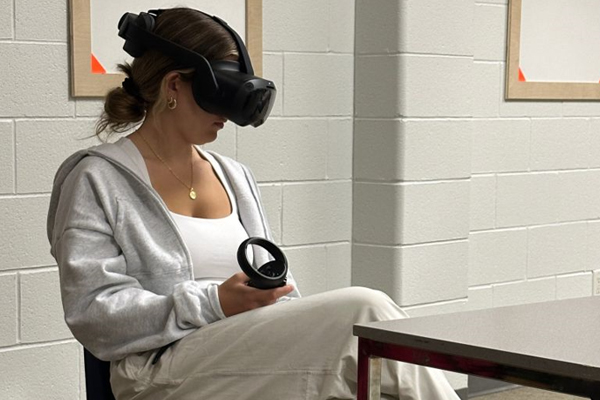
- Startup story: In 2023, Amanda Graham approached the Immersive Tech team about bringing contextual experiences to her students through virtual reality. She created an assignment for her International students where they selected a 360 video that represented the city, village or country from where they came. Using the Engage XR platform, students were able to give a presentation in VR. In 2024, Amanda was seconded to another position and XR took a pause. In 2025, she returned and XR was reestablished in EAP.
- Professor(s): Amanda Graham
- Hardware: Meta Quest 2
- Software: Engage
- Deployment Strategy: Students created Engage accounts and two to three times per semester the Immersive Tech team would bring up to 15 headsets to the classroom for the students to participate in a shared 360 video.
- Startup story: In the fall of 2020, the Indigenous Studies Program started a pilot using VR for language learning in a course called Language in the Home. It just made sense that if you’re learning language in the home, why not do it in a home?! There is good evidence to support context-based learning for improving language retention and VR is like a field trip for every class. Inside and outside of the house, objects are labeled in the Anishinaabemowin and English words (video) so that students can go into the environment between classes to study and socialize. On Thursdays, students meet with their teacher for 30-45 minutes in virtual reality in avatar form. On a regular basis, an elder from the Indigenous community will join them in virtual reality for conversations and storytelling. In the Winter of 2021 students took a course called Language in the Community where they met in a small virtual town. We have also built new and more robust worlds for a platform called Engage. There, students are able to click on audio files of the Anishinaabemowin words to help with pronunciation. In addition, they are able to interact with objects e.g. pick up pots, cups and food. The students and faculty love the feeling of presence and the added benefit of context-based learning so much that they have purchased additional VR headsets and are now using VR for both 1st and 2nd year students. Students have said that they love being in VR and that it “feels like you’re really there with other people”.
- Professor(s): Angeline King (Professor), Michele O’Brien (Professor – Coordinator)
- Course(s): Language in the Home, Language in the Community, Language in the Workplace, Language in the Natural Environment
- Hardware: Meta Quest 2
- Software: We use the Engage platform. We’ve contracted third party developers to build several virtual worlds. These virtual worlds provide context for language learning. Every class is like a field trip.
- Deployment Strategy: Headsets are owned by the Indigenous Studies Program area and are loaned to students on a semester basis.
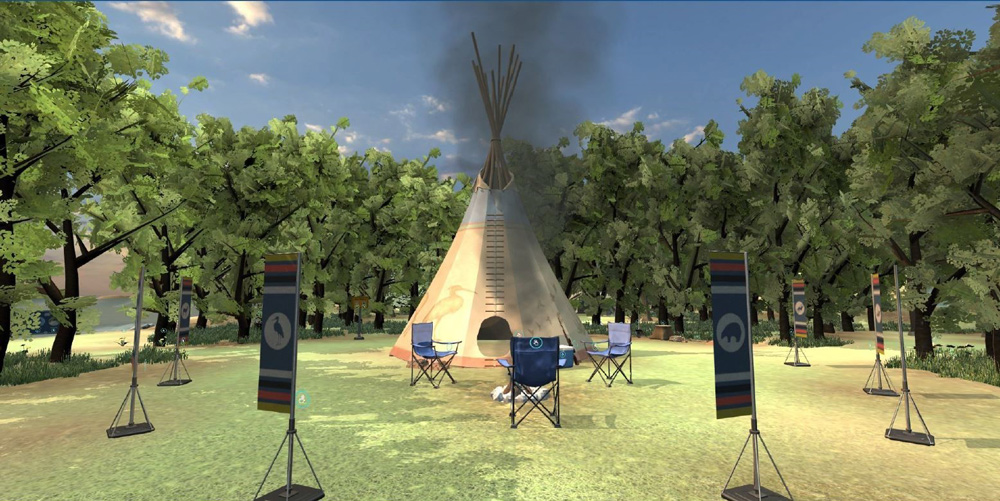
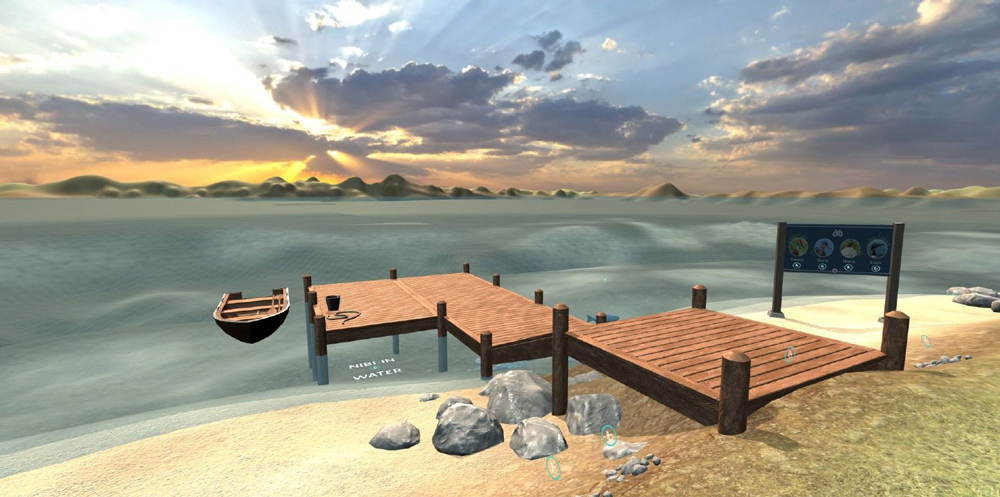
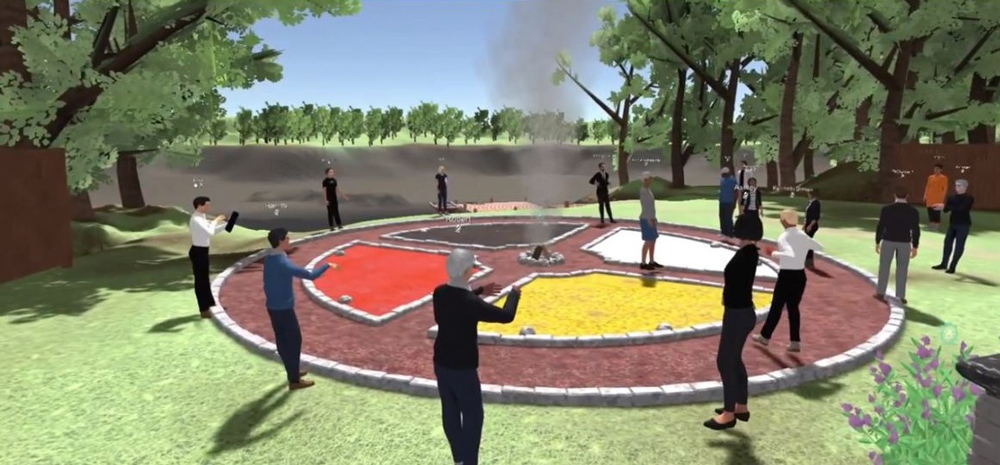
- Startup story: September 2025
- Hardware: Quest 2, Quest 3/3s
- Software: Gravity Sketch (Meta)
- Deployment Strategy: Loan headsets or in-class events (TBA)
- Evidence:
- Hamurcu, A., Timur, Ş., & Yıldırım, K. (2020). An overview of virtual reality within industrial design education. Journal of Engineering, Design and Technology, 19(1), 218-234.
- Noghabaei, M., Asadi, K., & Han, K. (2019). Virtual manipulation in an immersive virtual environment: Simulation of virtual assembly. arXiv preprint arXiv:1902.05099.
- Lin, W., Chen, L., Xiong, W., Ran, K., & Fan, A. (2023). Measuring the sense of presence and learning efficacy in immersive virtual assembly training. arXiv preprint arXiv:2312.10387.
- Kraus, M., Rust, R., Rietschel, M., & Hall, D. (2022). Improved perception of AEC construction details via immersive teaching in virtual reality. arXiv preprint arXiv:2209.10617.
- Noghabaei, M., Asadi, K., & Han, K. (2019). Virtual manipulation in an immersive virtual environment: Simulation of virtual assembly. arXiv preprint arXiv:1902.05099.
- Startup story: Winter, 2025
- Professor(s): Scott McCrindle
- Course(s): COMP 2144 Extended Reality and Emerging Technologies (4th semester)
- Hardware: Quest 2
- Software: MetaVRse
- Deployment Strategy: Students will borrow VR headsets for the semester.
- Startup story: In the fall, 2023, Andrea Vorstermans-Zado, the coordinator of the Interior Design Degree Program approached the Immersive Tech team to explore VR for space design.
- Professor(s): Andrea Vorstermans-Zado, Dr. Tara O’Neil
- Course(s): INDE1006, INDE3007 Interdisciplinary Practice
- Hardware: Meta Quest 2
- Software: Arkio
- Deployment Strategy: Students each borrow a VR headset from the library, create their own Meta account and download whatever software they need or wish to explore. These headsets and not managed under a mobile device management (MDM) system.
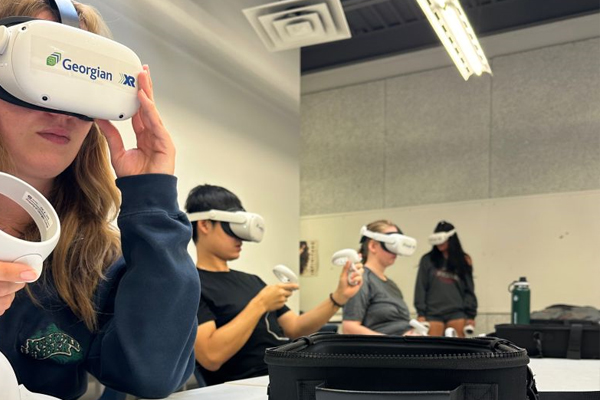
- Startup story: September 2022: In 2023, the program was paused due to costs.
- Professor(s): Gregg Trunnel, Kent Simpson
- Hardware: PCVR with the HP Reverb G2
- Software: Morild Navigator VR (multiplayer)
- Deployment Strategy: Ship headsets and computers out to shipping companies who coordinate distance learning for their staff.
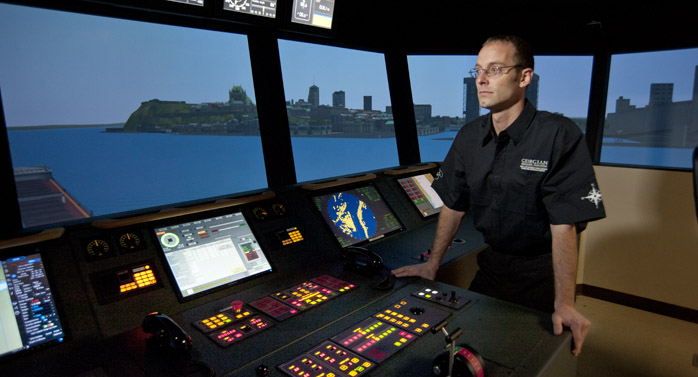
- Startup story: September 2023
- Professor(s): Jed Gibbons
- Course(s): Power Plant Simulation 1
- Hardware: Quest 2 + PC (PCVR)
- Software: UP360 Boiler Plant Simulator
- Deployment Strategy: VR Lab
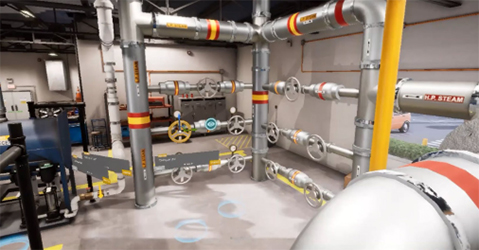
- Startup story: September 2023: Professor Marilyn Nigro first introduced virtual reality to the Events Management Program in 2021 and later to Tourism with the help of Professor Gary Don in 2024. The aim is to introduce VR and MR to tourism students to help them reimagine how tourism might incorporate XR throughout the industry.
- Professor(s): Gary Don, Marilyn Nigro
- Hardware: Meta Quest 2
- Software: Various apps: e.g. Fly, Ocean Rift MR, AR New York City, Art Plunge
- Deployment Strategy: 2-3 VR events take place in the classroom every semester. The Immersive Tech team brings VR headsets to the class and guides students through a variety of XR experiences.
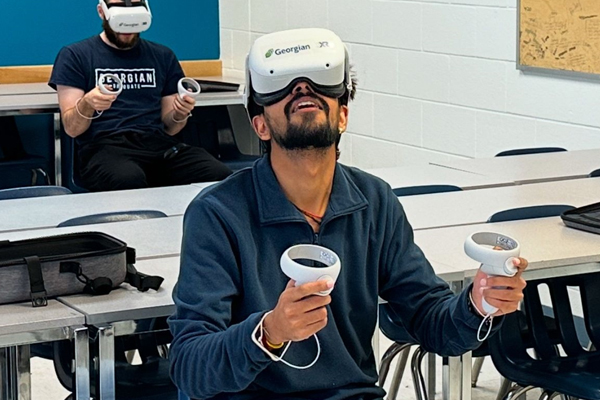
- Startup story: September 2021: Animal dissection apps were provided to students. However, since there are no analytics associated with the apps and therefore no way to track what the students do in VR, it cannot be used for summative assessments. As of 2024, the VR headsets and apps are available as a resource in the library.
- Professor(s): Jody Gillespie
- Course(s): Anatomy
- Hardware: Meta Quest 2
- Software: VictoryXR animal dissection, Engage XR
- Deployment Strategy: Students are able to borrow headsets from the library.
- Startup story: September 2021: Animal dissection apps were provided to students. However, since there are no analytics associated with the apps and therefore no way to track what the students do in VR, it cannot be used for summative assessments. As of 2024, the VR headsets and apps are available as a resource in the library.
- Professor(s): Jody Gillespie
- Course(s): Anatomy
- Hardware: Meta Quest 2
- Software: VictoryXR animal dissection, Engage XR
- Deployment Strategy: Students are able to borrow headsets from the library.
Departments and XR-AI
- Startup story: September 2021
- Professor(s): Adam Dagenais
- Hardware: Quest 2
- Software: Event based XR activities. Software varies.
- Deployment Strategy: Purchased their own headsets.
- Startup story: September 2023
- Professor(s): Varies each semester
- Course(s): Indigenous Global Perspectives (GenED)
- Hardware: Quest 3
- Software: Engage XR
- Deployment Strategy: On-class VR events
- Startup story: September 2024
- Professor(s): Gordon Nicoll
- Hardware; Vive Focus 3
- Software: Bodyswaps
- Deployment Strategy: Headsets deployed for various events
- Startup story: September 2022
- Hardware: Quest 2
- Software: Engage XR, Nature Trek, Guided Meditation
- Deployment Strategy: Scheduled Mindfulness Events
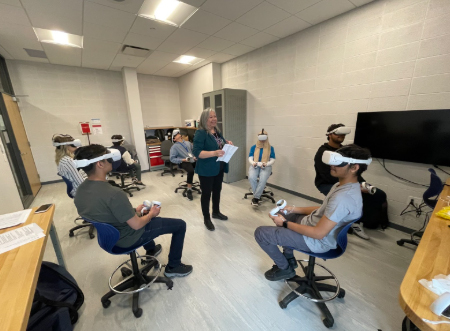
Indigenous Peoples in XR (IPXR)
Startup story: September 2021: About a year after faculty in the Indigenous Studies program began teaching the Anishinaabe language in virtual reality, the word of their success began to spread through Indigenous communities in Canada and around the globe.
At an event in virtual reality, we, along with one of the founding Directors of Educators in VR, Daniel Bryan came up with the idea of sharing the Indigenous worlds with other Indigenous schools and communities. Hence, the concept of Indigenous Peoples in XR (IPXR) was born. However, this concept rested on the back burner through the height of the Covid 19 Global Pandemic.
In late 2022, after some school boards in Ontario expressed an interest in IPXR, the Centre for Research, Innovation and Entrepreneurship partnered with Indigenous Studies and the Centre for Teaching and Learning’s Immersive Technology team to make IPXR an official organization. Now, when Indigenous schools or communities want to get access to our Indigenous virtual reality worlds, they join us through a Memorandum of Alliance to get access to our worlds on the Engage XR platform.
Current Members (updated November 2024):
- Georgian College (lead organization)
- Ontario
- Dufferin Peel Catholic District School Board
- Simcoe County District School Board
- Simcoe Muskoka Catholic District School Board
- Manitoba
- University College of the North
- Saskatchewan
- Saskatchewan Indian Institute of Technologies
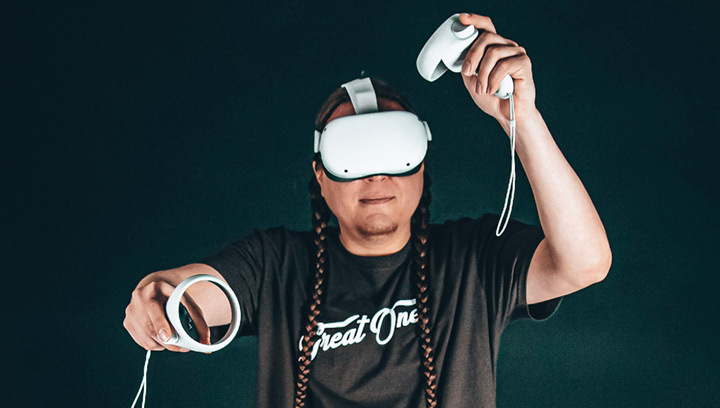
Professor(s):
Angeline King, Michele O’Brien, Rob Theriault
Hardware: Meta Quest, Vive
Software: Engage XR
Special project
Intelligent Tutoring Systems development
Proposal for a student capstone project: Intelligent tutoring system using AI and XR
Submitted by: Rob Theriault, Immersive Technology Manager
Intelligent Tutoring Systems (ITS) have roots in the intelligent computer-assisted learning (ICAI) concept from the 1960s and 1970s. The first ITS conference was held in 1988, at which time the phrase “intelligent tutoring systems” took off (source).
Since the introduction of large language models for generative artificial intelligence (GenAI) such as ChatGPT in November 2022, ITS has become much simpler to leverage for student learning. However, higher education has been focused on the problem with cheating and finding ways to discover and police the cheating rather than thinking of learning differently.
While the conversations and activities around chatting and policing are important, I propose that we take action to explore how students will learn and how learning will be assessed differently using GenAI and XR (virtual, mixed and augmented reality). I am looking for students to assist me with the development of an ITS that leverages AI and XR for the subject of anatomy and physiology. The ITS will facilitate student learning while looking and interacting with a physical anatomical model.
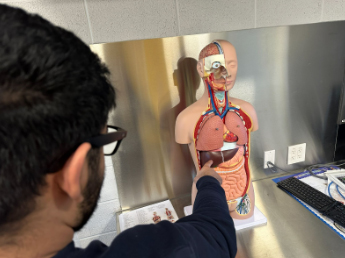
- Feed a course outline and syllabus to understand the learning objectives.
- Content & model: open-source textbook + human torso and skeletal model.
- AI will inform students at all levels of Bloom’s Taxonomy through inquiry.
- AI will quiz the student using a Socratic method to dig deep into what they know, understand, can apply and evaluate their higher order thinking.
- Phase 1: Smart glasses with a forward-facing camera coupled with AI and computer vision will be the medium for interaction.
- Lessons will be adapted to the learner’s needs.
- Analytics will provide feedback on the learning achieved.
- Phase 2: AR headset coupled with AI. In addition to computer vision the AI can create content in real time e.g. an animated graph that appears in the students’ field of view through the AR glasses.
- Phase 3: After seeing content or having a discussion using AR, a student might ask a question that requires an auditory, visual and tactile experience. So, the AI might suggest that the student don their VR headset. The AI can generate 3D content in real time e.g. an animated patient on a ventilator in the intensive care unit that appears. The students can then have a conversation with the AI about the patient’s clinical presentation. They would also be able to pick up a stethoscope to listen to the patient’s chest.
- A student stands in front of an anatomical model wearing AI enabled smart glasses (or AR) e.g. Ray Ban Smart Glasses or AR glasses.
- The student points to a structure such as a bone or an organ and asks the AI to identify the structure. The glasses are able to do this by tracking the student’s finger/hand.
- The student will ask additional questions about form and function e.g. what is the primary purpose or function of the liver? What is the approximate weight of the liver in an average size adult? What diseases affect the liver?
- At certain time intervals the AI will ask the student questions to confirm what they know, understand, can apply and think critically about.
- Th analytics will provide the student and the teacher with feedback on what the student has learned and match it to the learning objectives of the course.
In select programs, intelligent tutoring systems will do the heavy lifting of Bloom’s Taxonomy. It will provide adaptive learning, i.e. individualized instructions to meet the student’s learning needs. It will assess and report on what the student knows, understands and can think critically about. It will be a tool for a “flipped classroom” so that the teacher can spend more time with the students doing cased based learning project-based learning, critical thinking exercises.
Connect with us
We are happy to help investigate potential XR options to use with your students. If you require support, please connect with:
Rob Theriault
Immersive Technology Manager
Centre for Teaching and Learning

“My role is to help faculty explore and integrate virtual, mixed and augmented reality, collectively known as XR, into curriculum.”
